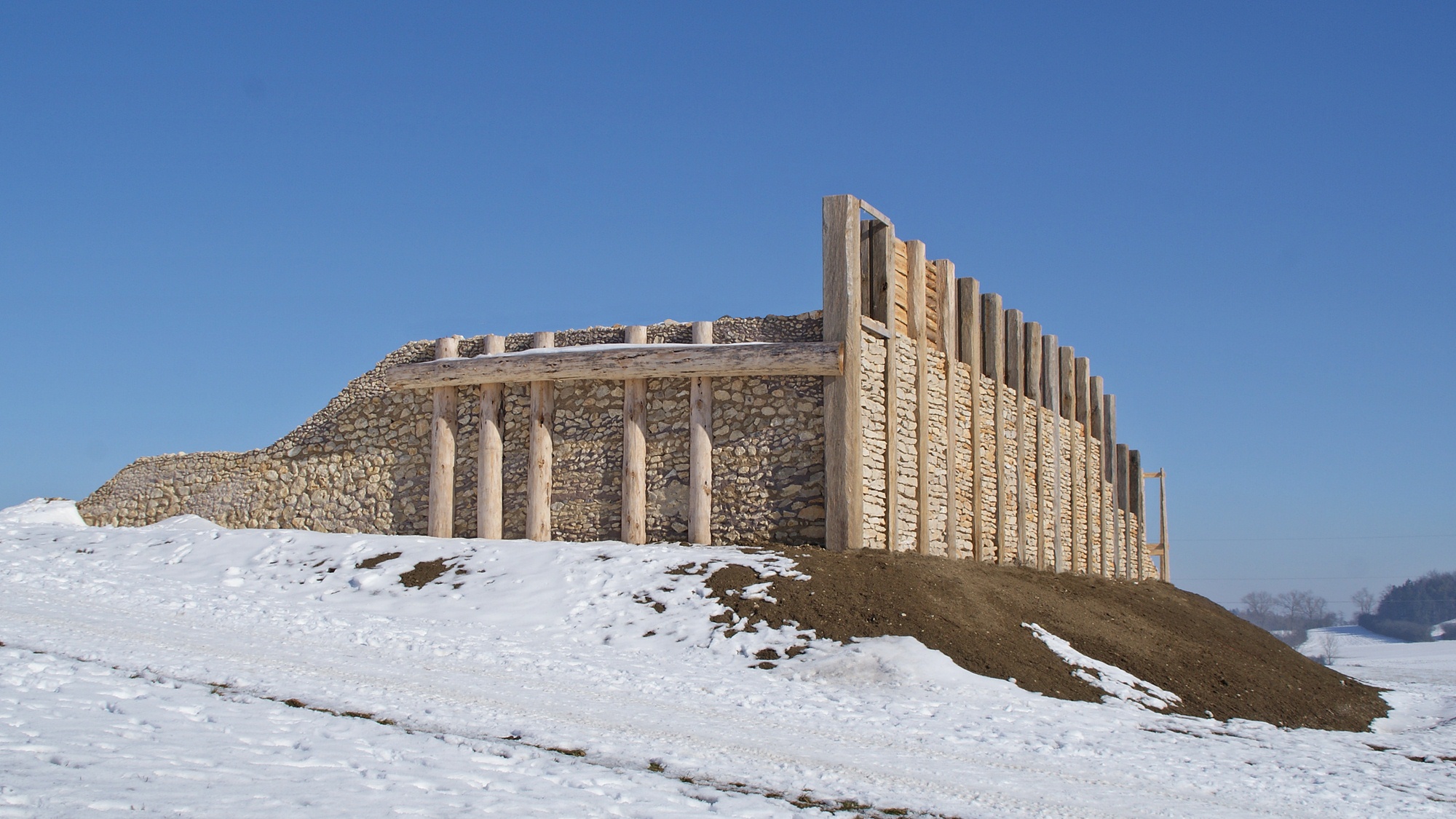Pfostenschlitzmauer on:
[Wikipedia]
[Google]
[Amazon]
 A ''Pfostenschlitzmauer'' (German for "post-slot wall") is the name for
A ''Pfostenschlitzmauer'' (German for "post-slot wall") is the name for
File:2018 Rheinisches Landesmuseum Trier, Keltischer Wehrmauer.jpg, Model of a ''Pfostenschlitzmauer'' wall of the "Altkönig-Preist" type
File:Murus Gallicus 2.jpg, Reverse view
File:Keltische Steinmauer auf dem Kordigast.jpg, ''Pfostenschlitzmauer''-type fortification wall
defensive wall
A defensive wall is a fortification usually used to protect a city, town or other settlement from potential aggressors. The walls can range from simple palisades or earthworks to extensive military fortifications with towers, bastions and gates ...
s protecting Iron Age
The Iron Age is the final epoch of the three-age division of the prehistory and protohistory of humanity. It was preceded by the Stone Age (Paleolithic, Mesolithic, Neolithic) and the Bronze Age (Chalcolithic). The concept has been mostly appl ...
hill fort
A hillfort is a type of earthwork used as a fortified refuge or defended settlement, located to exploit a rise in elevation for defensive advantage. They are typically European and of the Bronze Age or Iron Age. Some were used in the post-Roma ...
s and ''oppida
An ''oppidum'' (plural ''oppida'') is a large fortified Iron Age settlement or town. ''Oppida'' are primarily associated with the Celtic late La Tène culture, emerging during the 2nd and 1st centuries BC, spread across Europe, stretch ...
'' in Central Europe, especially in Bavaria
Bavaria ( ; ), officially the Free State of Bavaria (german: Freistaat Bayern, link=no ), is a state in the south-east of Germany. With an area of , Bavaria is the largest German state by land area, comprising roughly a fifth of the total lan ...
and the Czech Republic
The Czech Republic, or simply Czechia, is a landlocked country in Central Europe. Historically known as Bohemia, it is bordered by Austria to the south, Germany to the west, Poland to the northeast, and Slovakia to the southeast. The ...
. They are characterized by vertical wooden posts set into the front stone facing. The rampart
Rampart may refer to:
* Rampart (fortification), a defensive wall or bank around a castle, fort or settlement
Rampart may also refer to:
* "O'er the Ramparts We Watched" is a key line from "The Star-Spangled Banner", the national anthem of the ...
is constructed from a timber lattice filled with earth or rubble. The transverse cross-beams may also protrude through the stone facing, as with the ''murus gallicus
''Murus gallicus'' or Gallic wall is a method of construction of defensive walls used to protect Iron Age hillforts and ''oppida'' of the La Tene period in Western Europe.
Basic features
The distinctive features are:
* earth or rubble f ...
'' used in Gaul
Gaul ( la, Gallia) was a region of Western Europe first described by the Romans. It was inhabited by Celtic and Aquitani tribes, encompassing present-day France, Belgium, Luxembourg, most of Switzerland, parts of Northern Italy (only during ...
and western Germany. It is sometimes referred to in English as a timber-framed wall.
The construction method is also known as "Kelheim-style", named after the extensive ramparts at the oppidum of Kelheim
Kelheim () is a town and municipality in Bavaria, Germany. It is the capital of the district Kelheim and is situated at the confluence of the rivers Altmühl and Danube. Kelheim has a population of around 16,750 (2020).
History
Kelheim is t ...
.
At the oppidum of Manching
The Oppidum of Manching (german: Oppidum von Manching) was a large Celtic proto-urban or city-like settlement at modern-day Manching, near Ingolstadt, in Bavaria, Germany. The Iron Age town (or oppidum) was founded in the 3rd century BC and exis ...
, an earlier ''murus gallicus'' rampart was rebuilt in ''Pfostenschlitzmauer'' style.
See also
* '' Murus Dacicus'' * ''Murus Gallicus
''Murus gallicus'' or Gallic wall is a method of construction of defensive walls used to protect Iron Age hillforts and ''oppida'' of the La Tene period in Western Europe.
Basic features
The distinctive features are:
* earth or rubble f ...
''
* Urnfield culture
The Urnfield culture ( 1300 BC – 750 BC) was a late Bronze Age culture of Central Europe, often divided into several local cultures within a broader Urnfield tradition. The name comes from the custom of cremating the dead and p ...
* Hallstatt culture
The Hallstatt culture was the predominant Western Europe, Western and Central European Archaeological culture, culture of Late Bronze Age Europe, Bronze Age (Hallstatt A, Hallstatt B) from the 12th to 8th centuries BC and Early Iron Age Europe ...
References
* ''The Ancient Celts'',Barry Cunliffe
Sir Barrington Windsor Cunliffe, (born 10 December 1939), known as Barry Cunliffe, is a British archaeologist and academic. He was Professor of European Archaeology at the University of Oxford from 1972 to 2007. Since 2007, he has been an Emeri ...
(1997)
* ''Celtic Fortifications'', Ian Ralston (2006)
* ''Manching: Die Keltenstadt'', Susanne Sievers (2003),
{{Authority control
Fortification (architectural elements)
Hill forts
Oppida
Iron Age Europe
German words and phrases